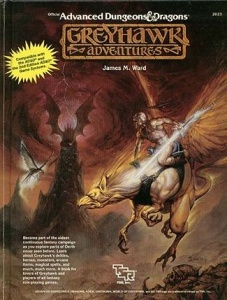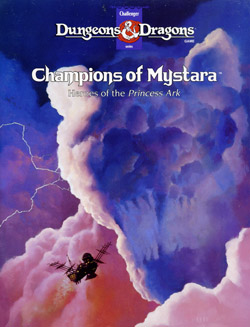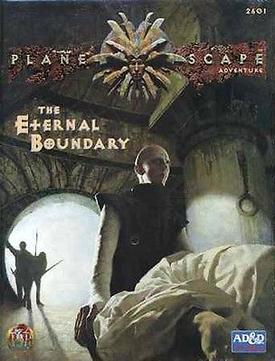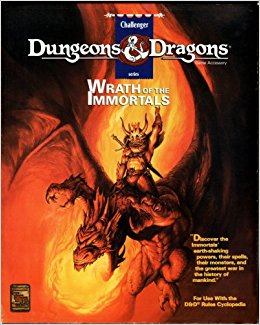 | |
| Genre | Role-playing game |
|---|---|
| Publisher | TSR |
| Media type | Boxed set |
Planes of Chaos was a boxed set for the Planescape campaign setting of the Dungeons & Dragons fantasy role-playing game.
 | |
| Genre | Role-playing game |
|---|---|
| Publisher | TSR |
| Media type | Boxed set |
Planes of Chaos was a boxed set for the Planescape campaign setting of the Dungeons & Dragons fantasy role-playing game.
Planes of Chaos is a boxed set supplement for the Planescape campaign setting which describes the five Outer Planes of chaotic aligment: Arborea, Ysgard, Limbo, Pandemonium, and the Abyss. The expansion boxed set includes the "Travelogue," a 48-page guide for players; "The Book of Chaos," a 128-page book intended for the Dungeon Master; "Chaos Adventures," a 32-page book which outlines 15 adventures, three for each of the planes detailed in the set; a 32-page "Monstrous Supplement" with statistics for 15 new monsters; and one poster for each plane. [1]
The set's four volumes, spanning some 240 pages, reveal the secrets of the spectre wars of airless Naratyr, describe an elven city concealed in the limbs of Grandfather Oak, and explore the Infinite Staircase of Ysgard that winds through all time and space. A text-packed poster map summarizes dozens of the layers of Abyss. [2]
Planes of Chaos was designed by Lester Smith and Wolfgang Baur, and was published by TSR. [2] The box cover art was by Robh Ruppel, with conceptual and booklet cover art by Dana Knutson, and interior art by Tony DiTerlizzi. The set was released in 1994.
Rick Swan reviewed Planes of Chaos for Dragon magazine #214 (February 1995). [2] He commented on the set: "Of the various subdivisions of the AD&D game cosmology, the chaotic planes are arguably the most interesting and potentially the most disappointing. For years, we've been assured that Limbo, the Abyss, and Pandemonium are mind-blowing locales teeming with adventure possibilities. But in the absence of hard information—anyone recall seeing a Pandemonium source book?—we've had to take these assurances on faith. This dazzling Planescape setting boxed set exceeds expectations." [2] Swan concluded by saying that "With crisp prose and vivid descriptions, Smith and Baur not only have captured the settings eerie majesty, but have done so in astonishing detail." [2]
Keith H. Eisenbeis reviewed Planes of Chaos for White Wolf magazine, rating it a 2 out of 5 overall. [1] He felt that while the art on most of the recent TSR products was a most attractive feature, the art of Planes of Chaos was "relatively abundant but uninspired and simplistic" and that the color sides of the map posters were too abstract. He also found the constant insertion of the setting's fictional slang terms irritating. [1] He also found it disappointing that the authors seemed to have purposely pulled the product away from historical mythology in many cases, despite the wealth of material available to draw on from real-world mythology and previous D&D works. Eisenbeis did find that the alterations of the core rules for magic and combat on each plane were easy to understand and use, but cautioned that the task of running a balanced long-term campaign may be difficult. He noted that the essentially immutable nature of the planes – given that each plane always remains true to its nature, apparently nullifying or rendering characters' efforts useless – made the process of adventuring in them unlikely. He also felt that adventuring in these planes would be "highly improbable or obviously contrived" for low- and mid-level characters, because designing a situation in which such characters can accomplish something important and survive would undermine the immensity and power of the planes. [1] Eisenbeis concluded the review by stating, "Information presented on the planes is not extensive, art is simplistic and the potential for long-term adventuring, except for high-level characters, seems limited." [1]

Planescape is a campaign setting for the Dungeons & Dragons fantasy role-playing game, designed by Zeb Cook, and published in 1994. It crosses numerous planes of existence, encompassing an entire cosmology called the Great Wheel, as developed previously in the 1987 Manual of the Planes by Jeff Grubb. This includes many of the other Dungeons & Dragons worlds, linking them via inter-dimensional magical portals.
The slaad is a fictional monster in the Dungeons & Dragons fantasy role-playing game. They are extraplanar creatures (outsiders) that resemble giant humanoid toads of various colors, and other types, such as mud, and death slaadi.
In the fantasy role-playing game Dungeons & Dragons, an Outer Plane is one of a number of general types of planes of existence. They can also be referred to as godly planes, spiritual planes, or divine planes. The Outer Planes are home to beings such as deities and their servants such as demons, celestials and devils. Each Outer Plane is usually the physical manifestation of a particular moral and ethical alignment and the entities that dwell there often embody the traits related to that alignment.

The planes of the Dungeons & Dragons roleplaying game constitute the multiverse in which the game takes place. Each plane is a universe with its own rules with regard to gravity, geography, magic and morality. There have been various official cosmologies over the course of the different editions of the game; these cosmologies describe the structure of the standard Dungeons & Dragons multiverse.

The Manual of the Planes is a manual for the Dungeons & Dragons role-playing game. This text addresses the planar cosmology of the game universe.

Greyhawk Adventures is an accessory for the Advanced Dungeons & Dragons (AD&D) World of Greyhawk campaign setting.
The Arms and Equipment Guide is the name of two supplementary rule books for the Dungeons & Dragons fantasy role-playing game. Each describes various equipment that can be used in a campaign.

The Complete Book of Humanoids is a sourcebook for the second edition of the Advanced Dungeons & Dragons fantasy adventure role-playing game.

Sigil is a fictional city and the center of the Planescape campaign setting for the Dungeons & Dragons fantasy role-playing game.

The Ruins of Undermountain is a boxed set for the Forgotten Realms campaign setting for the second edition of the Advanced Dungeons & Dragons fantasy role-playing game. The set was written by Ed Greenwood and published by TSR. It featured box cover art by Brom. and was published in 1991.

Dungeons & Dragons Immortals Rules, written by Frank Mentzer, is a boxed set for the Dungeons & Dragons (D&D) fantasy role-playing game first published by TSR in 1986 as an expansion to the Basic Set.

The Planescape Campaign Setting is a boxed set for the Dungeons & Dragons fantasy role-playing game. The set was designed by David "Zeb" Cook and published in 1994. It introduced the Planescape setting and was highly praised by White Wolf and Pyramid magazines.

Ravenloft: Realm of Terror is a boxed set accessory published in 1990 for the Ravenloft campaign setting for the Advanced Dungeons & Dragons fantasy role-playing game.

Champions of Mystara is an accessory for the Dungeons & Dragons fantasy role-playing game, published in 1993.

Creative Campaigning is an accessory for the 2nd edition of the Advanced Dungeons & Dragons fantasy role-playing game, published in 1993.
The Wand of Orcus is a fictional magical weapon described in various Dungeons & Dragons media. Because of the popularity of Orcus as a villain within the Dungeons & Dragons universe, many different authors have written materials describing artifacts created by or associated with the character. The Wand of Orcus is consistently the most important and most described of these artifacts. Screen Rant has noted that "[t]he weapon that Orcus wields in battle is almost as famous as the demon lord himself". Furthermore, the device has at times been employed in books, games, and other media within the franchise as a thing distinct from Orcus himself, such that adventurers may encounter the wand as a freestanding element of the game or story.

Tales of the Lance is a boxed set issued by TSR for Dragonlance. It includes maps, source books, and player stat cards for various non-player characters (NPCs).

The Eternal Boundary is an adventure module for the 2nd edition of the Advanced Dungeons & Dragons fantasy role-playing game.

Wrath of the Immortals, written by Aaron Allston, is a boxed set for the Dungeons & Dragons (D&D) fantasy role-playing game first published by TSR in 1992, revising the rules of the Immortals Rules box set that was originally released in 1986.